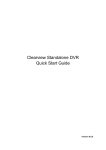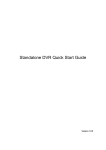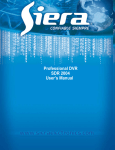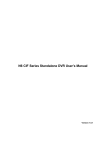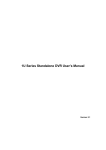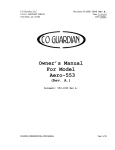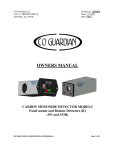Download Forensic NVR Quick Start Guide
Transcript
Forensic NVR Quick Start Guide Version 2.2.0 Table of Contents 1 Hardware Installation and Connection..........................................................................1 1.1 Check Unpacked NVR........................................................................................1 1.2 About Front Panel and Rear Panel ..................................................................1 1.3 After Remove the Chassis .................................................................................1 1.4 HDD Installation...................................................................................................1 1.5 Front Panel...........................................................................................................2 1.6 Rear Panel ...........................................................................................................3 1.7 Connection Sample.............................................................................................3 1.8 Alarm Input and Output Connection.................................................................4 1.8.1 Alarm Input and Output Details.................................................................4 1.8.2 Alarm Input Port...........................................................................................5 1.8.3 Alarm Output Port........................................................................................5 2 Overview of Navigation and Controls............................................................................6 2.1 Login, Logout & Main Menu...............................................................................6 2.1.1 2.1.2 2.1.3 2.1.4 Login..............................................................................................................6 Main Menu....................................................................................................7 Logout ...........................................................................................................7 Auto Resume after Power Failure ............................................................8 2.2 Live Viewing .........................................................................................................8 2.3 PTZ Control ..........................................................................................................9 2.4 PIP Setup ...........................................................................................................13 2.4.1 Video 1-4 PIP.............................................................................................13 2.4.2 4-window PIP mode ..................................................................................14 2.5 Real-time Burning and CD Playback..............................................................15 2.6 Overlay Temperature/Humidity Information ..................................................18 2.6.1 RS232 Mode ..............................................................................................18 2.6.2 RS485 Mode ..............................................................................................20 i 3 2.7 Backup ................................................................................................................22 2.8 CD Copy .............................................................................................................23 2.9 CD Verification...................................................................................................23 Web Operation................................................................................................................26 3.1 Network Connection..........................................................................................26 3.2 Login....................................................................................................................26 3.2.1 3.2.2 3.2.3 3.2.4 Real-time Monitor ......................................................................................28 PTZ ..............................................................................................................30 Color ............................................................................................................33 Picture Path and Record Path.................................................................33 Appendix Toxic or Hazardous Materials or Elements .....................................................35 ii Welcome Thank you for purchasing our NVR! This quick start guide will help you become familiar with our NVR in a very short time. Before installation and operation, please read the following safeguard and warning carefully! Important Safeguard and Warning 1.Electrical safety All installation and operation here should conform to your local electrical safety codes. We assume no liability or responsibility for all the fires or electrical shock caused by improper handling or installation. 2.Transportation security Heavy stress, violent vibration or water splash are not allowed during transportation, storage and installation. 3.Installation Keep upwards. Handle with care. Do not apply power to the NVR before completing installation. Do not place objects on the NVR. 4.Qualified engineers needed All the examination and repair work should be done by the qualified service engineers. We are not liable for any problems caused by unauthorized modifications or attempted repair. 5.Environment The NVR should be installed in a cool, dry place away from direct sunlight, inflammable, explosive substances and etc. 6. Accessories Be sure to use all the accessories recommended by manufacturer. Before installation, please open the package and check all the components are included: Contact your local retailer ASAP if something is missing in your package. 7. Lithium battery Improper battery use may result in fire, explosion, or personal injury! When replace the battery, please make sure you are using the same model! iii 1 Hardware Installation and Connection Note: All the installation and operations here should conform to your local electric safety rules. 1.1 Check Unpacked NVR When you receive the NVR from the forwarding agent, please check whether there is any visible damage. The protective materials used for the package of the NVR can protect most accidental clashes during transportation. Then you can open the box to check the accessories. Please check the items in accordance with the list. (Remote control is optional). Finally you can remove the protective film of the NVR. Note Remote control is not a standard accessory and it is not included in the accessory bag. 1.2 About Front Panel and Rear Panel For detailed information of the function keys in the front panel and the ports in the rear panel, please refer to the User’s Manual included in the resource CD. The model label in the front panel is very important; please check according to your purchase order. The label in the rear panel is very important too. Usually we need you to represent the serial number when we provide the service after sales. 1.3 After Remove the Chassis Please check the data cable, power cable, COM cable and main boar cable connection is secure or not. 1.4 HDD Installation You can refer to the User’s Manual for recommended HDD brand. Please follow the instructions below to install hard disk. This series NVR has two SATA HDDs. Please use HDD of 7200rpm or higher. All the figurers listed below are for reference only. Slight difference may be found on the front or rear panel. 1. Take the HDD bracket out 2. Place the HDD to the holes of 3. Secure the brackets of the two of the accessories bag and the bracket and then use the sides on the HDD. then place the four gaskets to screws to fix firmly. the four holes. . 1 4. Unfasten the screws of the 5. Use special data cable to 6. Place the bracket in line with rear and side panel of the device. connect the HDD cable and power the four holes of the device and cable. then use screws to fix from the bottom. 7. Put the cover in accordance 8. Secure the screws in the with the clip and then place the rear panel and the side panel. upper cover back. Important z When there is a bracket, please make sure the installation direction of HDDs is the same. z Please pay attention to the front cover. It adopts the vertical sliding design. You need to push the clip first and then put down. 1.5 Front Panel The front panel is shown as in Figure 1-1. Figure 1-1 Please refer to the following sheet for front panel button information. Button Name HDD record indicator light Network abnormal indicator light Icon 1-4 NET Function The corresponding HDD is recording when it is on. It is to alert you when network is abnormal or no connection. 2 Remote control indicator light Power indicator light Burning Start/stop Cancel Microphone Line audio input Line audio output USB port ACT REC/ST OP ESC Remote control indicator light The light is on when power connection is OK. z REC:Start burning. z STOP:Stop burning. Exit Microphone port. Line audio input port. Line audio output port. Connect to mouse, HDD and etc. 1.6 Rear Panel The series NVR rear panel is shown as below. See Figure 1-2. Figure 1-2 Please refer to the following sheet for detailed information. 1 Audio output 2 Video output 3 Network port 4 VGA output 5 RS232 port 6 HDMI port 7 USB port 8 eSATA port 9 Alarm input/alarm output/RS485 port 10 Line audio input port 11 Microphone port When connect the Ethernet port, please use crossover cable to connect the PC and use the straight cable to connect to the switcher or router. 1.7 Connection Sample Please refer to Figure 1-3 for connection sample. 3 Figure 1-3 1.8 Alarm Input and Output Connection There are two alarm input types for you to select: normal open (NO) and normal close (NC). 1.8.1 Alarm Input and Output Details AB cable connection Figure 1-4 You can refer to the following sheet for alarm input and output information. ALARM 1 to ALARM 4. The alarm becomes active in low voltage. 1,2,3,4, NO1 C1,NO2 C2 There are two groups of normal open activation output (on/off button) Earth cable. 485 A/B 485 communication port. They are used to control devices such as PTZ. Please parallel connect 120TΩ between A/B cables if there are too many PTZ decoders. 4 1.8.2 Alarm Input Port Please refer to the following sheet for more information. z Normal open or Normal close type. z Please parallel connect COM end and GND end of the alarm detector (Provide external power to the alarm detector). z Please parallel connect the Ground of the NVR and the ground of the alarm detector. z Please connect the NC port of the alarm sensor to the NVR alarm input(ALARM) z Use the same ground with that of NVR if you use external power to the alarm device. Figure 1-5 1.8.3 Alarm Output Port z z z Provide external power to external alarm device. To avoid overloading, please read relay parameters sheet in the User’s Manual carefully. RS485 A/B cable is for the A/B cable of the PTZ decoder. 5 2 Overview of Navigation and Controls Before operation, please make sure: z You have properly installed HDD and all the cable connections. z The provided input power and the device power are matched. z The external power shall be AC100~240V 50+2% Hz. z Always use the stable current, if necessary UPS is a best alternative measure. 2.1 Login, Logout & Main Menu 2.1.1 Login After system booted up, system pops up the startup wizard. Click the Cancel button; you can go to the system login interface. Click the Next Step button; you can go to the startup wizard interface. Here you can set the system basic information. See Figure 2-1. Figure 2-1 The system login interface is shown as in Figure 2-2. System consists of four accounts: z z z Username: admin. Password: admin. (administrator, local and network) Username: 888888. Password: 888888. (administrator, local only) Username: 666666. Password: 666666(Lower authority user who can only monitor, playback, backup and etc.) z Username: default. Password: default(hidden user) You can use USB mouse, front panel, remote control (not included in the accessory bag) or keyboard to input. About input method: Click to switch between numeral, English character (small/capitalized) and denotation. Note: For security reason, please modify password after you first login. Continuous three times login failure will result in system alarm and six times login failure will result in account lock! 6 Figure 2-2 2.1.2 Main Menu After you logged in, the system main menu is shown as below. See Figure 2-3. There are total seven icons: search, Information, setting, backup, remote device, advanced and shutdown. You can move the cursor to highlight the icon, and then double click mouse to enter the sub-menu. Figure 2-3 2.1.3 Logout There are two ways for you to log out. The first one is from menu option: In the main menu, click shutdown button, you can see an interface is shown as below. See Figure 2-4. Figure 2-4 There are several options for you. See Figure 2-5. 7 Figure 2-5 The other ways is to press power button on the front panel for at least 3 seconds, system will stop all operations. Then you can click the power button in the front panel to turn off the NVR. Please note, before you replace the HDD, do remember shutting down the device and unplug the power cable. 2.1.4 Auto Resume after Power Failure The system can automatically backup video and resume previous working status after power failure. 2.2 Live Viewing After you logged in, the system is in live viewing mode by default. You can see system date, time and channel name. If you want to change system date and time, you can refer to general settings (Main Menu->Setting->General). If you want to modify the channel name, please refer to the display settings (Main Menu->Setting->Display). You can view there is a volume bar at the right bottom corner. The volume bar becomes red when it is the max value. 1 Recording status 3 Video loss 2 Motion detection 4 Camera lock Right click mouse, you can see system pops up the following menu. See Figure 2-6. Please refer to the following sheet for detailed information. Name View 1 View 4 View PIP Pan/Tilt/Zoom Auto focus Color Setting Search Record Remote device Real-time burn Alarm output Main menu Function System displays in one-channel. You can select channel 1 to channel 4. System displays in 4-window. System displays in picture in picture mode. One picture is big and one picture is small. Set PTZ parameter and realize fast positioning. Click it to adjust auto focus distance. Set video hue, brightness, contrast, saturation and gain. Please note you need to set a period here and the time format shall be 24H. Search record. Set record mode. It is the connected IPC setup. Click to go to real-time burn interface. Set alarm output mode. Go to main menu. 8 Figure 2-6 2.3 PTZ Control Before the operation, please go to Main Menu->Setting->Pan/Tilt/Zoom to set PTZ protocol first. In the one-window surveillance mode, right click mouse (click “fn” Button in the front panel or click AUX key in the remote control). Click Pan/Tilt/Zoom, the interface is shown as below. See Figure 2-7. Here you can set the following items: z Step: value ranges fro 1 to 8. z Zoom z Focus z Iris Please click icon and to adjust zoom, focus and iris. Figure 2-7 In Figure 2-7, please click direction arrows (See Figure 2-8) to adjust PTZ position. There are total 8 direction arrows. Figure 2-8 3D Intelligent Positioning Key 9 In the middle of the eight direction arrows, there is a 3D intelligent positioning key. See Figure 2-9. Please make sure your protocol supports this function and you need to use mouse to control. Click this key, system goes back to the single screen mode. Drag the mouse in the screen to adjust section size. The dragged zone supports 4X to 16X speeds. It can realize PTZ automatically. The smaller zone you dragged, the higher the speed. X Figure 2-9 Here is a sheet for you reference. Name Function function key Zoom Near Focus Near Iris close Shortcut key Function key │_ W function Far Far Open Shortcut Key ►│ f Preset/ Patrol/Pattern/Scan In Figure 2-7, please click the “set” button. The interface is shown as below. See Figure 2-10. Here you can set the following items: z Preset z Tour z Pattern z Border Figure 2-10 In Figure 2-7, click page switch button, the interface is shown as in Figure 2-11. Here you can activate the following functions: z Preset z Tour z Pattern z Auto scan z Auto pan z Flip z Reset z Page switch X328H 10 Figure 2-11 Note: z Preset, tour and pattern all need the value to be the control parameter. You can define it as you require. z You need to refer to your speed dome user’s manual for Aux definition. In some cases, it can be used for special process. z The following setups are usually operated in the Figure 2-7, Figure 2-10 and Figure 2-11. X32H Preset Setup In Figure 2-7, use eight direction arrows to adjust camera to the proper position. In Figure 2-10, click preset button and input preset number. The interface is shown as in Figure 2-12. Now you can add this preset to one tour. Figure 2-12 Activate Preset In Figure 2-11, please input preset number in the No. blank, and click preset button. Patrol setup (Tour Setup) In Figure 4-38, click patrol button. The interface is shown as in Figure 2-13.Input preset number and add this preset to a patrol (tour). For each patrol (tour), you can input max 80 presets. Figure 2-13 11 Activate Patrol (tour) In Figure 2-10, input patrol (tour) number in the No. blank and click patrol button X341H Pattern Setup In Figure 2-10, click pattern button and then click “begin” button. The interface is shown as in Figure 2-14. Then you can go to Figure 2-7 X to modify zoom, focus, and iris. Go back to Figure 2-14 and click “end” button. You can memorize all these operations as pattern 1. Figure 2-14 Activate Pattern Function In Figure 4-39, input mode value in the No. blank, and click pattern button. X346H Auto Scan Setup In Figure 4-38, click border button. The interface is shown as in Figure 4-43. Please go to Figure 4-35, use direction arrows to select camera left limit Then please go to Figure 4-43 and click left limit button Repeat the above procedures to set right limit. X347H X349H X348H X349H X350H X Figure 2-15 Activate Auto Scan In Figure 2-11, click “Auto Scan” button, the system begins auto scan. Correspondingly, the auto scan button becomes Stop button. Click stop button to terminate scan operation. Flip In Figure 2-11, click page switch button, you can see an interface is shown as below. See Figure 2-16. Here you can set auxiliary function. The aux value has relation ship with the Aux button of the decoder. Click page switch button again, system goes back to Figure 2-7. 12 Figure 2-16 In Figure 2-16,click Page Switch button, you can go to Figure 2-17.(Please note only SD1 and SD2 protocol can go to the following interface.) The direction button here ti to control the speed dome menu. The displayed button here may vary due to different protocol. The button is grey if current protocol does not support this function. Use up/down button to switch between menu items and use left/right button to change setup. Click enter/exit menu button to go to or exit speed dome menu. Click Page Switch button, system goes back to Figure 2-7. Figure 2-17 2.4 PIP Setup 2.4.1 Video 1-4 PIP You can view different channels on the PIP mode. You can follow the steps listed below. a) From main menu->setting->general, check the navigation bar to enable navigation function. Close general interface and then left click mouse on the preview interface, you can see an interface shown as in Figure 2-18. Figure 2-18 b) In Figure 2-18, click Tips: z to set a mode and then click . Now system goes to PIP mode. One the preview interface, right click mouse and then select View PIP mode, then click on Figure 2-18. You can go to PIP mode. 13 z The PIP mode uses one channel as the main window. You can select channel 1/23/4 as the main picture. c) On the PIP interface, click to display and then click at the top left corner to select a channel you want to save. In mode 1, you can select 2/3/4 as the PIP mode. Now you can see an interface shown as in Figure 2-19.You can use mouse to drag the PIP picture to the proper position and drag mouse to zoom in or zoom out. Figure 2-19 Note : The grey highlighted channel is the main channel. The white channel is the z z PIP channel and black channel is the current selected channel. On the PIP mode, the volume bar is the mixed audio. For mode 1 to mode 4, system can mix the audio of the main interface and the PIP interface. It is the audio of the PIP preview and record audio. 2.4.2 4-window PIP mode You can view 4-window on the PIP mode. You can follow the steps listed below. a) From main menu->setting->general, check the navigation bar to enable navigation function. Close general interface and then left click mouse on the preview interface, you can see an interface shown as in Figure 2-20. Figure 2-20 b) In Figure 2-20, click to set a mode and then click . Now system goes to 4-window PIP mode. 14 c) On the PIP interface, click display. You can select at the top left corner to select a channel you want to to set mixed audio and then click to save. See Figure 2-21. Figure 2-21 Note z z : can only be displayed on the first channel and can only be displayed on the second channel. You can click at the top left corner to set mixed audio. P1 is the mixed audio of channel 1 and channel 3. P2 is the mixed audio of channel 2 and channel 4. During the preview mode, you can not select P1 and P2 at the same time. It is the output audio of the preview interface, that is to say it is the audio of the channel P on the PIP mode. You can use mouse to drag the PIP picture to the proper position and drag mouse to zoom in or zoom out. 2.5 Real-time Burning and CD Playback This series product can burn real-time video to the CD for future reference. You can click the REC/STOP at the front panel to start or stop burning. Or you can go to the burning interface via the right-click mouse menu. Please follow the steps listed below. a) One the preview interface, right click mouse and then select real-time burning. You can see an interface shown as in Figure 2-22. Please note the record channel needs to set as P (PIP), otherwise, you can not see the three setup buttons on the right pane. 15 Figure 2-22 Tips z Click the REC/STOP at the front panel; you can go to burning interface. Click REC/STOP for a short time, you can begin or pause burning. If you click REC/STOP for a long time during the burning process, you can stop burning operation. z On the left-click mouse menu, select main menu and then click Backup button. Click Burning button, you can go to Figure 2-22 too. b) Select a device from the dropdown list and then select a record channel. c) Now you can set burn setup, mark setup and etc. Please note you can not set during the burning process. Click Settings button, you can see the following interface. See Figure 2-23. Here you can set interrogation time and resolution. Click Save button. System can calculate the corresponding channel bit stream according to you input information and the CD space. Figure 2-23 Click Burn setup, system pops up the following interface. See Figure 2-24.Please input record password twice to confirm and check the corresponding box here to select information you want to overlay on the burning record. Check the Check button at the bottom of the 16 interface, system can auto generate verification information during the burning process. You can use the verification information to check the data has been tampered with or not. For detailed CD verification information, you can view chapter 2.9. Figure 2-24 You can click Mark setup button if you want to mark during the burning process. d) Now you can click Start Sync burning on Figure 2-22 to begin burning. Note z Start sync burning: You can select one or more CD to burning at the same time. System burns the same data. System stops burning when it finishes burning. Or you can stop manually. z Start tour burning: You need to select several CD to begin circle burning. System begins burning from the first CD and then auto goes to the second CD until it finishes all CD burning. z Change CD: During the CD burning process, you can click it to replace CD manually. System pops up current CD and then you can input a new one. System begins burning data from the previous 5 minutes of the previous CD so that there is no missing data between these two CDs. z Pause: During the burning process, you can pause current burning if the court is adjournment. Click continue button, you can begin burning again and all data is on the same CD. e) Click OK button on the pop-up dialog box, after you complete the burning. CD Playback This function is for you to verify the real-time burning data. You can check the real-time burning data and backup data. On the preview interface and then right click mouse, select Search. Or you can go to the search interface, from main menu-search interface. In Search interface (Main menu->Search), select Play from CD from the dropdown list and then click file list switch button . You can see an interface shown as in Figure 2-25. Here you can view file list from the CD. Double click a file name, you can playback a file. 17 Figure 2-25 Important Real-time burning and CD playback can not be operated at the same time since these two functions are both for CD-ROM. 2.6 Overlay Temperature/Humidity Information After you connect device to temperature and humidity device, you need to set corresponding parameters so that you can overlay temperature humidity information on the monitor video or record file. You can connect the temperature humidity device via the RS232. 2.6.1 RS232 Mode a) Set COM protocol On the preview interface, right click mouse and then select main menu, from main menu>advanced->card overlay. The interface is shown as in Figure 2-26. Figure 2-26 18 Now you can set Sniffer mode as COM and protocol is RC or other protocols. Click COM setting button, you can see COM setup interface. See Figure 2-27. Now you can set RS232 information. The COM function is the protocol and the baud rate, data bit, stop bit shall be the same with the temperature humidity device. Click Save to save you setup. Figure 2-27 In Figure 2-26, select PIP channel from the dropdown list and then click overlay setup button, you can see the following interface. See Figure 2-28. Check the preview or monitor mode after T/H (Temperature/humidity) and then click Set button to set overlay position. Click Save button to exit. Figure 2-28 Tips z In Figure 2-28, click Set button, you can set overlay position. z Each channel can set its own overlay information. The channel 1-4 encode overlay position is corresponding to the overlay effect of its own channel during the preview. The PIP overlay position is corresponding to the 4-window and PIP preview overlay effect. 19 z Preview means you can overlay temperature humidity information on local preview window. Monitor means you can overly temperature humidity information on the record file so that you can view it when playback. b) Connect the temperature humidity device to the device via the RS232. Connect the A/B cable of the temperature humidity device to the A/B cable of the 485 to 232 tool. Connect the RS232 port of the 485 to 232 tool to the RS232 port of the device. Note: z Right now the temperature humidity sniffer mode adopts RS485 port. In case it may affect the RS485 PTZ control of the device, the temperature humidity output shall go through a RS485-232 tool so that you can connect the RS232 to the RS232 port of the device. z For some series RS485-232 tool , it may need power supplying. Otherwise, the data may not stable or there is no data at all. In this situation, device can not overlay information. 2.6.2 RS485 Mode a) Set COM protocol On the preview interface, right click mouse and then select main menu, from main menu>advanced->card overlay. The interface is shown as in Figure 2-26. Figure 2-29 Now you can set Sniffer mode as COM and protocol is RC or other protocols. Click COM setting button, you can see COM setup interface. See Figure 2-27. Now you can set COM information. The COM function is the PTZ matrix and the baud rate, data bit, stop bit shall be the same with the temperature humidity device. Click Save to save you setup. 20 Figure 2-30 In Figure 2-26, select the PIP channel (channel P) to overlay temperature/humidity information. Click overlay setup button, you can see the following interface. See Figure 2-28. Check the preview or monitor mode and then click Save button. Figure 2-31 Tips z In Figure 2-28, click Set button, you can set overlay position. You need to select channel P (PIP) to overlay information. z Preview means you can overlay temperature humidity information on local preview window. Monitor means you can overly temperature humidity information on the record file so that you can view it when playback. b) Connect temperature humidity device to the NVR Connect the A2 and Y2 cable at the rear panel of the NVR to the A (or “+”) cable of the temperature humidity device. Connect the B2 and Z2 cable at the rear panel of the NVR to the B (or “-”) cable of the temperature humidity device. 21 2.7 Backup NVR support USB device backup and network download. Here we introduce USB backup. You can refer to User’s Manual Chapter 5 Web Operation for network download backup operation. a) On the preview interface, right click mouse and then click main menu. b) Click backup button, the interface is shown as below. See Figure 2-32. Figure 2-32 c) Select a backup device and then click Backup button. System pops up the following interface. See Figure 2-33. d) Select backup device and then set channel, file start time and end time. Click add button, system begins search. All matched files are listed below. System automatically calculates the capacity needed and remained. Important If you want to backup PIP file, the channel shall be set as P. Figure 2-33 22 e) system only backup files with a √ before channel name. You can use Fn or cancel button to delete √ after file serial number. Click backup button, you can backup selected files. There is a process bar for you reference. When the system completes backup, you can see a dialogue box prompting successful backup. Note The file name format usually is: SN_CH+channel number+time Y+M+D+H+M+S. In the file name, the YDM format is the same as you set in general interface. (Main Menu ->Setting >General).File extension name is .dav. 2.8 CD Copy This function allows you to copy one CD contents to another CD. Please follow the steps listed below. On the preview interface, right click mouse and then click main menu. Click backup button, you can go to backup interface. Click CD copy button at the bottom of the interface. You can go to the following interface. See Figure 2-34. You can see some reference information at the right bottom corner of the interface. You can see the corresponding dialogue box after the copy operation. Figure 2-34 Note z During the backup process, system automatically playback current file. at the left bottom corner during the copy process, you can copy video data only. z Click z During the copy process, you can implement fast forward/backward, pause and resume function. 2.9 CD Verification If you have checked the verification function when you burn CD, you can use it to see the data has been tampered with or not. Please follow the steps listed below. See 23 On preview window, right click mouse and then select real-time burning. Click the burn setup button, you can go to the following interface. See Figure 2-35.Check the verification box at the bottom of the interface. Figure 2-35 After the burning operation, you can check the CD is original or not. On the preview interface, right click mouse and then select main menu. Click Backup button. Check CD Check button. You can see CD check interface shown as below. See Figure 2-36. Figure 2-36 Select a CD from the dropdown list at the bottom of the interface and then check the file(s) you want to verify. Now system automatically begins check operation. You can see the check result on the right column. System displays as success if the file is original. It is shown as failed if the file has no data, or some data is missing or the data has been tampered with. See Figure 2-37. 24 Figure 2-37 25 3 Web Operation There might be slightly difference in the interface due to different series. 3.1 Network Connection Before web operation, please check the following items: z Network connection is right z NVR and PC network setup is right. Please refer to network setup(main menu->setting>network) z Use order ping ***.***.***.***(* NVR IP address) to check connection is OK or not. Usually the return TTL value should be less than 255. z Open the IE and then input NVR IP address. z System can automatically download latest web control and the new version can overwrite the previous one. z If you want to un-install the web control, please run uninstall webrec2.0.bat. Or you can go to C:\Program Files\webrec to remove single folder. Please note, before you un-install, please close all web pages, otherwise the un-installation might result in error. 3.2 Login Open IE and input NVR address in the address column. For example, if your NVR IP is 10.10.3.16, then please input http:// 10.10.3.16 in IE address column. See Figure 3-1. Input your IP address here. Figure 3-1 System pops up warning information to ask you whether install webrec.cab control or not. Please click yes button. If you can’t download the ActiveX file, please modify your settings as follows. See Figure 3-2. 26 Figure 3-2 After installation, the interface is shown as below. See Figure 3-3. Please input your user name and password. Default factory name is admin and password is admin. Then you can select the login mode: LAN and WAN. Note: For security reasons, please modify your password after you first login. Figure 3-3 After you logged in, you can see the main window. See Figure 3-6. This main window can be divided into the following sections. z Section 1: there are five function buttons: configuration, search, alarm, about, log out. z Section 2: there are channel number and three function buttons: start dialog and local play, refresh. 27 z z z Section3: there are PTZ (chapter 3.2.2), color (chapter3.2.3) button and you can also select picture path and record path. Section 4:real-time monitor window. Please note current preview window is circled by a green rectangle zone. Section 5: Here you can view window switch button. You can also select video priority between fluency or real-time. System monitor window switch supports full screen/1-window/4-window/6-window/8window/9-window/13-window/16-window/20-window/25-window/36-window. See Figure 3-4. Figure 3-4 Preview window switch. System support 1/4/8/9/16-window real-time preview. Please you need to have the proper rights to implement preview operation. You can not preview if you have no right to preview the either channel. See Figure 3-5. Please note this series device does not support this function. Figure 3-5 Section1 Section 3 Section 4 Section 2 Section 5 Figure 3-6 3.2.1 Real-time Monitor In section 2, left click the channel name you want to view, you can see the corresponding video in current window. 28 On the top left corner, you can view device IP, channel number, network monitor bit stream. See Figure 3-7. 1 2 3 Figure 3-7 On the top right corer, there are six unction buttons. See Figure 3-8. 1 2 3 4 5 6 Figure 3-8 1: Digital zoom: Click this button and then left drag the mouse in the zone to zoom in. right click mouse system restores original status. z 2: Change show mode: resize or switch to full screen mode. z 3: Local record. When you click local record button, the system begins recording and this button becomes highlighted. You can go to system folder RecordDownload to view the recorded file. z 4: Capture picture. You can snapshoot important video. All images are memorized in system client folder \download\picture (default). z 5: Audio :Turn on or off audio.(It has no relationship with system audio setup ) z 6: Close video. Please refer to Figure 3-9 for main stream and extra stream switch information. z Figure 3-9 Open All You can click it to open all channels. Refresh You can use button to refresh camera list. Start Dialogue 29 You can click this button to enable audio talk. Click 【▼】 to select bidirectional talk mode. There are four options: DEFAULT,G711a,G711u and PCM. Please note, the audio input port from the device to the client-end is using the first channel audio input port. During the bidirectional talk process, system will not encode the audio data from the 1channel. Local Play The Web can playback the saved (Extension name is dav) files in the PC-end. Click local play button, system pops up the following interface for you to select local play file. See Figure 3-10. Figure 3-10 3.2.2 PTZ Before PTZ operation, please make sure you have properly set PTZ protocol. (Please refer to User’s Manual Setting-> Pan/Tilt/Zoom). Click PTZ button, the interface is shown as in Figure 3-11. 30 3D Intelligent Positioning Key You can click this icon to display or hide the PTZ control platform. Figure 3-11 3.2.2.1 Direction key and 3D positioning key In Figure 7-10, there are eight direction keys. In the middle of the eight direction keys, there is a 3D intelligent positioning key. Click 3D intelligent positioning key, system goes back to the single screen mode. Drag the mouse in the screen to adjust section size. It can realize PTZ automatically. 3.2.2.2 Speed System supports eight-level speed. You can select from the dropdown list. Speed 2 is faster than speed 1. 3.2.2.3 Zoom/Focus/Iris Here is a sheet for you reference. Name Function key Zoom Function Function key Function Near Far Focus Near Far Iris close Open In Figure 3-11, click PTZ setup button you can see the following interface. See Figure 3-12. 31 Figure 3-12 3.2.2.4 Auto Scan In Figure 3-12, move the camera to you desired location and then click left limit button. Then move the camera again and then click right limit button to set a right limit. 3.2.2.5 Pattern In Figure 3-12, you can input pattern value and then click start record button to begin PTZ movement. Please go back to Figure 7-11 to implement camera operation. Then you can click stop record button. Now you have set one pattern. 3.2.2.6 Preset In Figure 3-12, move the camera to your desired location and then input preset value. Click add button, you have set one preset. 3.2.2.7 Auto tour In Figure 3-12, input auto tour value and preset value. Click add button, you have added one preset in the tour. Repeat the above procedures you can add more presets in one tour. 3.2.2.8 Assistant You can select the assistant item from the dropdown list. See Figure 3-13. 3.2.2.9 Matrix This series product supports matrix extension function. You can control the video input and output switch 3.2.2.10 Light and wiper If your PTZ protocol supports the light and wiper control function. You can enable/disable the light or the wiper. 32 Figure 3-13 3.2.3 Color Click color button in section 3, the interface is shown as Figure 3-14. Here you can select one channel and then adjust its brightness, contrast, hue and saturation. (Current channel border becomes green). Or you can click default button to use system default setup. Figure 3-14 3.2.4 Picture Path and Record Path Click more button in Figure 3-14, you can see an interface is shown as in Figure 3-15. Figure 3-15 Click the record item; you can see there are two options: DAV/ASF. Click picture path button, you can see an interface is shown as in Figure 3-16. Please click choose button to modify path. 33 Figure 3-16 Click record path button, you can see an interface is shown as in Figure 3-17. Please click choose button to modify path. Figure 3-17 Click reboot button, system pops up the following dialogue box. See Figure 3-18. Please click OK to reboot. Figure 3-18 If there is local use logged in the system menu, or the Web logged in user has no right to reboot the device system pops up a dialogue box to alert you. For detailed operation information, please refer to the User’s Manual included in the resources CD. 34 Appendix Toxic or Hazardous Materials or Elements Component Name Toxic or Hazardous Materials or Elements Pb Hg Cd Cr VI PBB PBDE ○ ○ ○ ○ ○ ○ ○ ○ ○ ○ ○ ○ Circuit Board ○ ○ ○ ○ ○ ○ Fastener Wire and Cable/AC Adapter Packing Material Accessories ○ ○ ○ ○ ○ ○ ○ ○ ○ ○ ○ ○ ○ ○ ○ ○ ○ ○ ○ ○ ○ ○ ○ ○ Sheet Metal(Case) Plastic Parts (Panel) Note O: Indicates that the concentration of the hazardous substance in all homogeneous materials in the parts is below the relevant threshold of the SJ/T11363-2006 standard. X: Indicates that the concentration of the hazardous substance of at least one of all homogeneous materials in the parts is above the relevant threshold of the SJ/T11363-2006 standard. During the environmental-friendly use period (EFUP) period, the toxic or hazardous substance or elements contained in products will not leak or mutate so that the use of these (substances or elements) will not result in any severe environmental pollution, any bodily injury or damage to any assets. The consumer is not authorized to process such kind of substances or elements, please return to the corresponding local authorities to process according to your local government statutes. Note z For detailed operation introduction, please refer to our resource CD included in your package for electronic version of the User’s Manual. z Slight difference may be found in user interface. z All the designs and software here are subject to change without prior written notice. z All trademarks and registered trademarks mentioned are the properties of their respective owners. z z If there is any uncertainty or controversy, please refer to the final explanation of us. Please visit our website for more information. 35











































